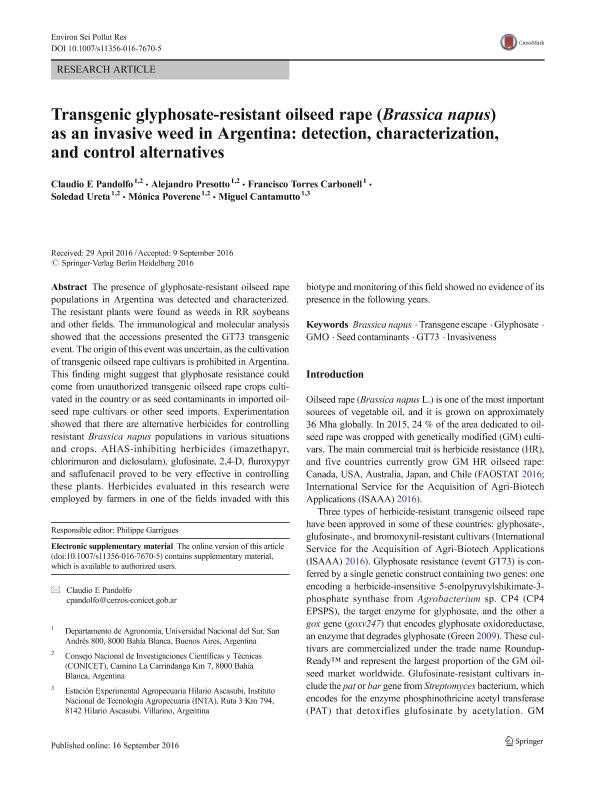Artículo
Transgenic glyphosate-resistant oilseed rape (Brassica napus) as an invasive weed in Argentina: detection, characterization, and control alternatives
Pandolfo, Claudio Ezequiel ; Presotto, Alejandro Daniel
; Presotto, Alejandro Daniel ; Torres Carbonell, Francisco Javier; Ureta, Maria Soledad
; Torres Carbonell, Francisco Javier; Ureta, Maria Soledad ; Poverene, María Mónica
; Poverene, María Mónica ; Cantamutto, Miguel Ángel
; Cantamutto, Miguel Ángel
 ; Presotto, Alejandro Daniel
; Presotto, Alejandro Daniel ; Torres Carbonell, Francisco Javier; Ureta, Maria Soledad
; Torres Carbonell, Francisco Javier; Ureta, Maria Soledad ; Poverene, María Mónica
; Poverene, María Mónica ; Cantamutto, Miguel Ángel
; Cantamutto, Miguel Ángel
Fecha de publicación:
12/2016
Editorial:
Springer Heidelberg
Revista:
Environmental Science And Pollution Research
ISSN:
0944-1344
Idioma:
Inglés
Tipo de recurso:
Artículo publicado
Clasificación temática:
Resumen
Abstract The presence of glyphosate-resistant oilseed rapepopulations in Argentina was detected and characterized.The resistant plants were found as weeds in RR soybeansand other fields. The immunological and molecular analysisshowed that the accessions presented the GT73 transgenicevent. The origin of this event was uncertain, as the cultivationof transgenic oilseed rape cultivars is prohibited in Argentina.This finding might suggest that glyphosate resistance couldcome from unauthorized transgenic oilseed rape crops cultivatedin the country or as seed contaminants in imported oilseedrape cultivars or other seed imports. Experimentationshowed that there are alternative herbicides for controllingresistant Brassica napus populations in various situationsand crops. AHAS-inhibiting herbicides (imazethapyr,chlorimuron and diclosulam), glufosinate, 2,4-D, fluroxypyrand saflufenacil proved to be very effective in controllingthese plants. Herbicides evaluated in this research wereemployed by farmers in one of the fields invaded with this biotype and monitoring of this field showed no evidence of itspresence in the following years.
Palabras clave:
Oilseed Rape
,
Transgene Escape
,
Glyphosate
,
Invasiveness
Archivos asociados
Licencia
Identificadores
Colecciones
Articulos(CERZOS)
Articulos de CENTRO REC.NAT.RENOVABLES DE ZONA SEMIARIDA(I)
Articulos de CENTRO REC.NAT.RENOVABLES DE ZONA SEMIARIDA(I)
Citación
Pandolfo, Claudio Ezequiel; Presotto, Alejandro Daniel; Torres Carbonell, Francisco Javier; Ureta, Maria Soledad; Poverene, María Mónica; et al.; Transgenic glyphosate-resistant oilseed rape (Brassica napus) as an invasive weed in Argentina: detection, characterization, and control alternatives; Springer Heidelberg; Environmental Science And Pollution Research; 23; 23; 12-2016; 24081-24091
Compartir
Altmétricas



